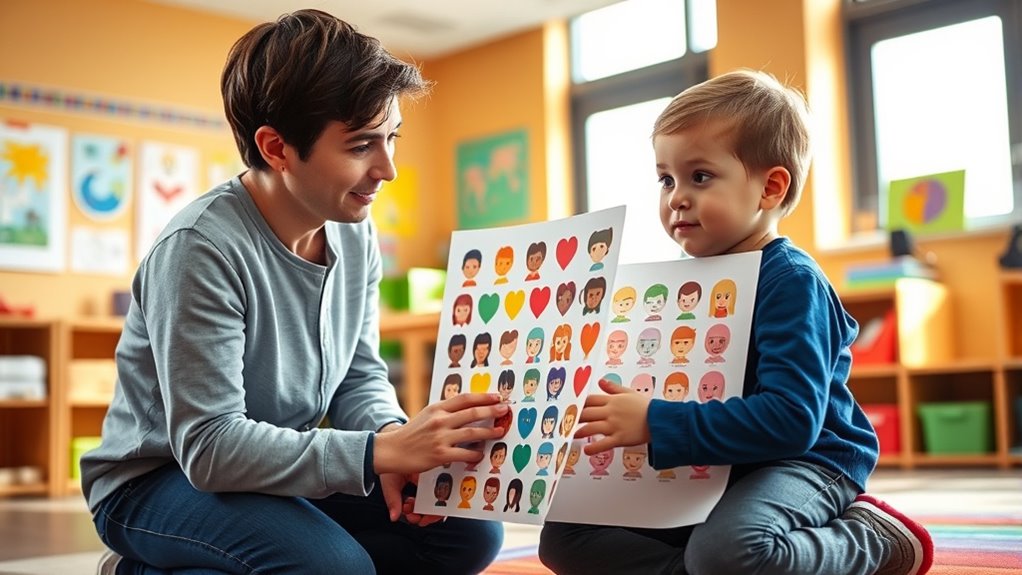To help kids name and tame big feelings, start by creating a supportive environment where they feel safe expressing themselves. Teach them to recognize early signs of emotions like anger or frustration and use strategies such as mindful breathing or taking a break. Practice consistently and validate their feelings without judgment. Over time, these techniques build their emotional resilience and self-control. Keep exploring effective methods to empower children in managing their emotions more confidently.
Key Takeaways
- Teach children to identify and label their emotions to enhance emotional awareness and vocabulary.
- Use mindful breathing techniques to help kids calm down during intense feelings.
- Create a supportive environment that encourages open expression without judgment.
- Introduce anger management strategies like taking deep breaths or physical activities to de-escalate.
- Practice consistently to reinforce skills, fostering self-awareness and long-term emotional regulation.

Emotion regulation is the process of managing and responding to your emotional experiences in a healthy and adaptive way. When you help kids develop these skills, you’re equipping them to handle life’s challenges more effectively. One powerful tool you can teach them is mindful breathing, which encourages them to focus on their breath to calm their minds and bodies. When children feel overwhelmed by big feelings like anger or frustration, guiding them to take slow, deep breaths can reduce their immediate emotional intensity. This practice helps them pause before reacting, giving them a moment to regain control and clarity. By modeling and encouraging mindful breathing, you teach kids that they have a simple, accessible way to soothe themselves during stressful moments. Developing a cozy, calming environment can further support children in feeling safe to express and process their emotions. Anger management is another essential aspect of emotion regulation you can help kids learn. When children experience anger, they often feel like they’re losing control, which can lead to impulsive outbursts or hurtful words. Teaching them to recognize the early signs of anger—like clenching fists or a racing heart—empowers them to take proactive steps to manage it. Incorporate techniques such as taking a break, counting to ten, or using a calming phrase to help them cool down. These strategies give children a sense of agency over their emotions, helping them avoid escalation. You can also introduce physical activities like squeezing a stress ball or doing a quick stretch to release tension. Consistent practice of these methods helps kids build resilience, making it easier for them to handle anger constructively over time. You play an essential role in guiding children through these processes by creating a supportive environment where they feel safe expressing their feelings. When you acknowledge their emotions without judgment and offer practical tools like mindful breathing and anger management techniques, you’re helping them develop a healthier emotional vocabulary. Over time, kids learn to name their feelings accurately, which is a key step in managing them effectively. Remember, patience and consistency are fundamental—these skills don’t develop overnight. By teaching kids to pause, breathe, and choose their responses, you’re empowering them to navigate their emotional worlds with confidence and self-control. Ultimately, fostering these skills not only helps children manage their big feelings now but also builds a strong foundation for their emotional well-being throughout their lives.
Frequently Asked Questions
How Can I Tell if My Child’s Emotion Regulation Skills Are Developing Properly?
You can tell your child’s emotional awareness and self-regulation skills are developing well if they recognize their feelings, express them appropriately, and manage their reactions. Notice if they can name their emotions and use calming strategies when upset. As they grow, they should handle setbacks better and show increased patience. Consistent progress in understanding and controlling their emotions indicates their emotion regulation skills are developing properly.
Are There Specific Activities That Help Kids Manage Anger More Effectively?
You can help your child manage anger more effectively through sensory activities like squeezing stress balls or playing with textured toys, which can soothe their nervous system. Incorporate calming routines such as deep breathing or quiet time to reduce agitation. Regularly practicing these activities helps your child recognize their triggers and develop better self-control, making it easier for them to calm down when anger flares up.
How Do I Handle Repeated Emotional Outbursts in Young Children?
Did you know that children with strong emotional vocabulary are 40% better at managing outbursts? When handling repeated emotional outbursts, stay calm and use calming techniques like deep breathing or counting. Teach your child emotional vocabulary to help them identify feelings. Consistent responses and patience help them learn to regulate emotions over time, reducing future outbursts. Your calm approach encourages them to develop healthier ways to express their feelings.
What Signs Indicate My Child Might Need Professional Emotional Support?
If you notice signs of emotional distress like persistent sadness, intense anger, or frequent withdrawal, your child might need professional support. Early intervention indicators include difficulty managing emotions, trouble in social situations, or drastic behavior changes. Trust your instincts—if these signs persist or worsen, seek help promptly. Addressing these early can make a big difference in your child’s emotional well-being and development.
How Can I Model Healthy Emotion Regulation for My Child?
Imagine painting a vibrant picture of calm—your parent modeling shows emotional literacy in action. You can do this by openly sharing your feelings, like saying, “I’m feeling a bit overwhelmed,” and using calming strategies. When your child sees you handle emotions with patience and honesty, they learn healthy ways to manage their own feelings. Your example becomes a guiding light, helping them develop their emotional skills naturally.
Conclusion
By coaching kids to identify and manage their feelings, you help them build emotional resilience. Visualizing emotions as weather patterns—stormy, sunny, or cloudy—can make big feelings easier to understand and tame. Just like weather changes, emotions are temporary and manageable. When you teach kids to recognize and name their feelings, you’re giving them a powerful tool to navigate life’s ups and downs. Together, you create a calmer, more balanced emotional landscape.








